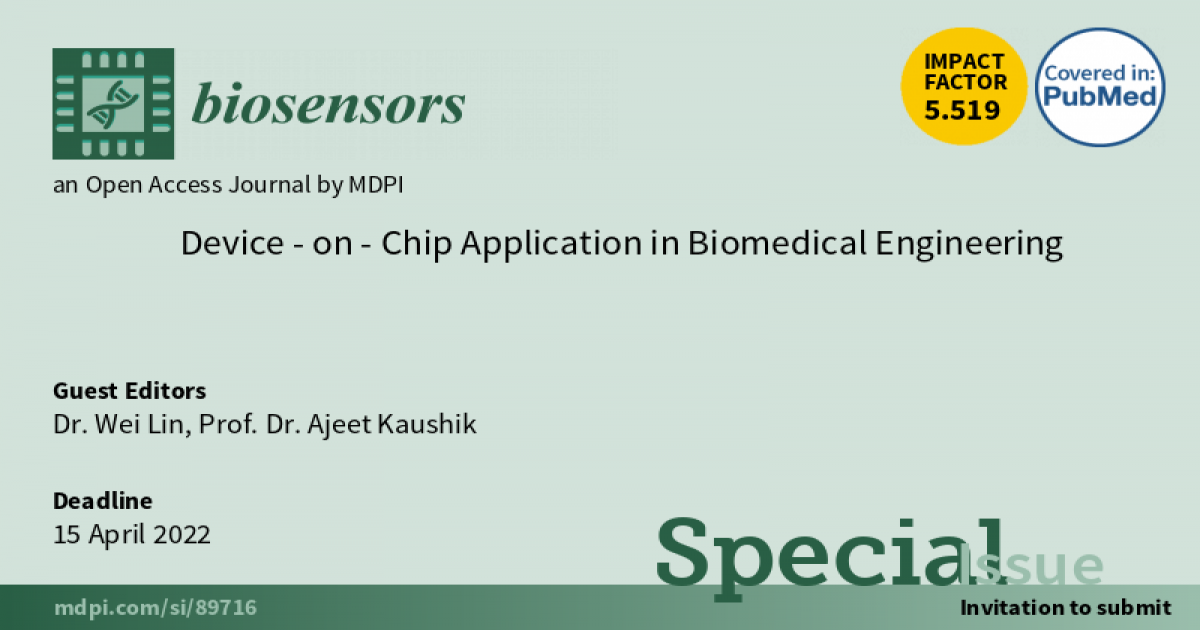Device-on-Chip Application in Biomedical Engineering
A special issue of Biosensors (ISSN 2079-6374). This special issue belongs to the section "Biosensor and Bioelectronic Devices".
Deadline for manuscript submissions: closed (30 April 2023) | Viewed by 11887

Special Issue Editors
Interests: medical device; biosensor; bio-optics; device on a chip; wearable device; ultrasound
Special Issues, Collections and Topics in MDPI journals
Interests: functional materials; polymers; sensors; biosensors; nanomedicine drug delivery systems
Special Issues, Collections and Topics in MDPI journals
Special Issue Information
Dear Colleagues,
Biosensors have the potential to deliver point-of-care diagnostics and remote biological sensing that can match or even surpass the conventional technologies. With the development of nanotechnology, sensors and the measurement electronics can be miniaturized while maintaining the high level of sophistication. The challenge lies in the integration of sensors with their control and data acquisition along with achieving high-performance data analysis, which can create a device-on-chip solution for real-time application. Microcontrollers and FPGAs are frequently employed in those applications. This Special Issue is soliciting original research in this area with the following areas of focus:
- Miniaturized sensor technology for device-on-a-chip
- Novel integration platforms for sensor control and data acquisition using embedded electronics such as microcontroller and FPGA
- Real-time sensor data processing using FPGA technology
- Integration of deep learning technology with sensors as a device-on-chip solution
- High-performance data analysis and high data throughput of image sensors
Dr. Wei Lin
Prof. Dr. Ajeet Kaushik
Guest Editors
If you want to learn more information or need any advice, you can contact the Special Issue Editor Jessica Zhou via <jessica.zhou@mdpi.com> directly.
Manuscript Submission Information
Manuscripts should be submitted online at www.mdpi.com by registering and logging in to this website. Once you are registered, click here to go to the submission form. Manuscripts can be submitted until the deadline. All submissions that pass pre-check are peer-reviewed. Accepted papers will be published continuously in the journal (as soon as accepted) and will be listed together on the special issue website. Research articles, review articles as well as short communications are invited. For planned papers, a title and short abstract (about 100 words) can be sent to the Editorial Office for announcement on this website.
Submitted manuscripts should not have been published previously, nor be under consideration for publication elsewhere (except conference proceedings papers). All manuscripts are thoroughly refereed through a single-blind peer-review process. A guide for authors and other relevant information for submission of manuscripts is available on the Instructions for Authors page. Biosensors is an international peer-reviewed open access monthly journal published by MDPI.
Please visit the Instructions for Authors page before submitting a manuscript. The Article Processing Charge (APC) for publication in this open access journal is 2700 CHF (Swiss Francs). Submitted papers should be well formatted and use good English. Authors may use MDPI's English editing service prior to publication or during author revisions.
Keywords
- FPGA
- microcontroller
- sensor
- biosensor
- high-performance computing
- high data throughput
- sensor control
- device-on-chip







